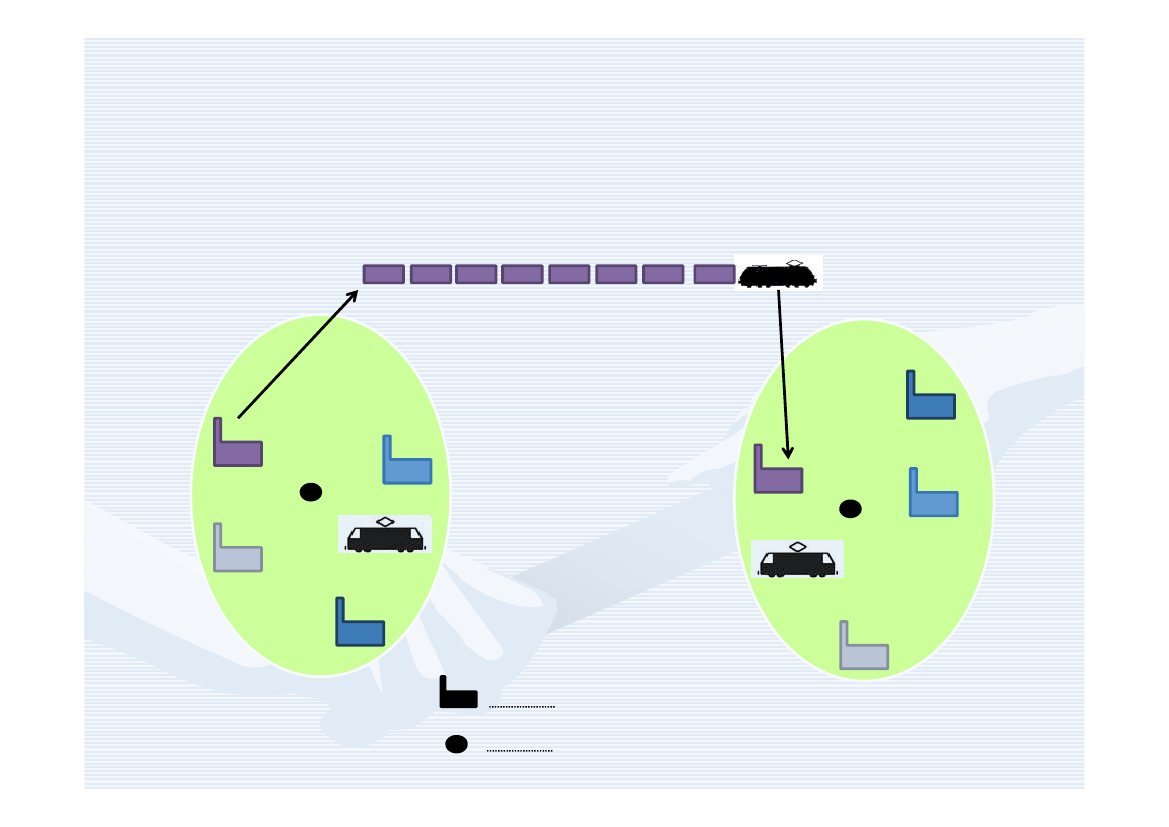Transportudvalget 2012-13
TRU Alm.del Bilag 133
Offentligt
Rail Transport Policy Strategyin Austria
29 October 2012Bundesministerium für Verkehr, Innovation und TechnologieWien
1
What are the General Objectives ofthe Austrian Transport Policy? (I)•The transport policy has to follow strategic guidelines!•The primary task of the Austrian transport policy:– to enable the mobility of people and goods– to minimise the negative effects on man and environment
•The broad orientation of the Austrian transport policy:– consideration and shaping of the spatial, social and economic structures
2
What are the General Objectives ofthe Austrian Transport Policy? (II)The Austrian Federal Ministry for Transport, Innovation andTechnology has defined 10 guidelines:Affordable mobilitySafe mobilitySustainable mobilityEfficient transport systemReliable transport systemFitting mobility informationTransparent transport policyParticipative transport policyCooperative transport systemPredictable transport system3
What are the Concrete Objectives forthe Rail Transport?Following objectives derive from the guidelines concerning the railtransport:Provision of a safe and modern transport infrastructureProvision of a basic range of services in rail passenger transportShift of freight transport onto the railways
4
Government Programme 2008 – 2013 (I)
These concrete objectives for the rail transport are alsoreflected in theGovernment Programme
5
Government Programme 2008 – 2013 (II)•Efficient infrastructure- and traffic managementinfrastructure-•Railway Infrastructure Campaign•Customer-oriented, improved service supply of regional publicCustomer-passenger transport on the rail•Promotion of the rail freight transport•Optimisation and simplification of the structure of the AustrianFederal Railways (ÖBB)•ETCS6
Efficient Infrastructure- and TrafficInfrastructure-ManagementThe aim of the efficient infrastructure- and traffic management isinfrastructure-to guarantee the mobility necessary for economic developmentin a sustainable way.Against this background, in particular the attractiveness of therail should be enforced.
7
Railway Infrastructure CampaignImportant contribution towards shifting transport from roads torailwaysThe transport policy objective, concerning the shift fromroad to rail, is pursued by the bmvit with a package ofmeasures.The prerequisite for this “shift-policy” is an adequate capacity“shift-on the rail. That is why measures are being taken in order tocreate sufficient railway infrastructure conditions.conditions.
8
Shift of Transport onto the Railways:TransportRailways:Prerequisite Infrastructure•Target Network 2025+(Strategy)Consistent overall conceptProvision of capacities on the international rail freight routes, as well asefficient freight terminals in the metropolitan areasCriteria for an adequate demand for freight feeder routesDevelopment of tailor-made strategies on a case by case basis for freightfeeder routes
•Investment Programme 2013-2018 (adopted on 16 October2012)9
Rail Passenger Transport•For congested areas a high quality public transport is a questionof economic survival.•For rural areas the public transport is an essential preconditionfor mobility and serves the social justice. Therefore, the publictransport supply should be made more attractive in these areas.•Regional public passenger transport is an important alternative toreduce the greenhouse gas emission, as well as the fine dust andnitrogen oxide emissions without the reduction of mobility.10
Organisation and Financing of thePublic Passenger Transport (I)•The (regional) public passenger transport is mainly covered bythe public sector in organisational and financial matters.•Based on a clear appointment of competences between thefederal, regional and local authorities the award of publictransport services and its financing must be shaped in a EU-compliant, transparent and performance-oriented way.
11
Organisation and Financing of thePublic Passenger Transport (II)•Open Access•e.g. WESTbahn Management GmbH (competitor on main corridor)•Rail Liberalisation Index 2011: „Advanced“
•Compliance with 1st Railway Package•Holding structure of the ÖBB-Group(separation of operating business from infrastructure)•Rail Regulatory Bodies•Monitoring: Schienen-Control GmbH•Complaints: Schienen-Control Kommission12
Organisation and Financing of thePublic Passenger Transport (III)Regulatory Framework•REGULATION (EC) No. 1370/2007•Local and Regional Public Passenger Transport Act 1999(ÖPNRV-G 1999)•§ 48 Bundesbahngesetz (Federal Railways Act)•§ 4 Privatbahngesetz 2004 (Private Railways Act)•Bundesvergabegesetz 2006 (Public Procurement Act)
13
Organisation and Financing of thePublic Passenger Transport (IV)Organisational Conditions•Dominance of unprofitable traffics•Duality of public authorities due to the Local and Regional PublicPassenger Transport Act 1999•Art. 7: Responsibility offederal authorityto guarantee a basic supply of services inlocal and regional public transport by rail to the extent of the services ordered orprovided in the timetable year 1999/2000.•Art. 11: Responsibility ofregional and local authorities(provinces andmunicipalities) to plan a demand-oriented transport service (reduction, expansion orrestructuring of transport services)
14
Organisation and Financing of thePublic Passenger Transport (V)First step: Direct Awards of Public Rail Passenger Services•in conformity with Regulation (EC) 1370/2007•according to Article 5 para. 6 (no prohibition by national law)•Contract period: 10 years•Bonus malus system to improve quality of services•Volumes: ÖBB-PV AG – approx. 71 million km p.a.private rail companies – approx. 6 million km p.a.Compensation:ÖBB-PV AG – approx. 600 million EUR p.a.private rail companies – approx. 50 million EUR p.a.
15
Preview: Service Supply of RailPublic Passenger Transport•Study examining experiences of public tenders of rail publicpassenger transport services in other European countries.•Public Service Contract already allows premature termination ofservice bundles (lots) in order to enable incremental andcontrolled deregulation (public tender).•Program for synchronised timetables “Systemfahrplan” inpreparation.16
Rail Freight Transport (I)•Unlike in other European countries, where the rail freighttransport has been strongly shifted to the roads for cost reasons,Austria could keep a very high share of rail freight transportwithin the freight transport modal split.•A European-wide comparison shows that Austria is a countrywith one of the highest shares of modal split on the rail.•Hence, in 2008, with a contribution of 37 % of total transport,Austria had the 4thlargest share of modal split on the rail inEurope (see Eurostat Pocket books, Energy, transport and environmentindicators, edition 2010, p.110-111).17
Rail Freight Transport (II)•Key factors for this high share of rail freight transport in Austriaare the still existing transport in areas with low and/or scatteredmobility demand and the rail freight aid schemes.•The rail has not only a transport policy-related but also anpolicy-economic-economic- and location policy-related component (Austria as apolicy-business location!).The promotion of the rail freight transport is not only asupport of the railway undertakings but it is also of majorimportance for the economic and location policy!18
Rail Freight Transport (III)•Austria notified an aid to the Commission for the provision ofcertain combined transport services by rail for the periodbetween 3 December 2012 and 31 December 2017, which hasbeen considered to be compatible with the internal market underArticle 93 TFEU.•Until 2 December 2012 Austria also granted public serviceobligations in rail freight transport based on Council Regulation(EEC) No 1191/69.
19
Transport Policy Objectives of theAid Scheme for Rail FreightTransportThe aid should affect these forms of freight rail transport, whichare, due to their characteristics, most exposed to competition bythe road!That means that in future block train transport is not going to bepromoted anymore.
20
What is going to be supported in RailFreight Transport?The objectives of the notified aid scheme are to support railservices in the following three forms of freight rail transport:•Single Wagonload Traffic (SWT)•Unaccompanied Combined Transport (UCT)•Accompanied Combined Transport (RoLa)
21
Single Wagonload Traffic•In Austria efforts are being made to keep this market segment,which is mainly responsible for the current high share of modalsplit on the rail.•In the absence of aid for Single Wagonload Traffic, there is adanger that also in Austria railway undertakings would have towithdraw the transport from areas with low and/or scatteredmobility.
22
Comparison Block Train vs. SWT (I)Block Trains
Source
Destination
Company / Connecting RailwayShunting Node
Comparison Block Train vs. SWT (II)Single Wagonload TrafficSourceDestination
high costs
Company / Connecting RailwayShunting Node
Optimisation and Simplification ofthe Structure of the Austrian FederalRailways (ÖBB)•Until 2009 there were twoInfrastructure
Companies of theAustrian Federal Railways:Betrieb AG:operation
, maintenance, inspection and repairoperation,
Bau AG:construction
, planning and replacement investmentsconstruction,
•Since 1.1.2009 merged into one:Maintenance and replacement investments to be in one handPositive effect: quality of network has risen noticeably25
ETCS•Several railway lines, which have been equipped with ETCS –Level 2, will be put into service during the next years in Austria.•In order to make the best use of these railway lines, it isnecessary that the railway undertakings will soon have enoughrail vehicles, which are equipped with ETCS – Level 2-suitable2-systems.•Therefore an ETCS – Aid scheme for the equipment of railvehicles with ETCS – Level 2 with an amount of EUR 45 millionin total has been notified to the Commission in 2011. The firstsubsidy will be paid out at the end of 2012.26
Summary / Prospect•Austria has a good starting position regarding the railwaytransport (high share of modal split on the rail).•Difficulties in the future (general economic development; railfreight transport is cyclical: highly dependent on themacroeconomic situation).•With the described package of measures the high share of modalsplit on the rail should be preserved to a large extent.•We will see whether we succeed!27
Thank you…
28




























